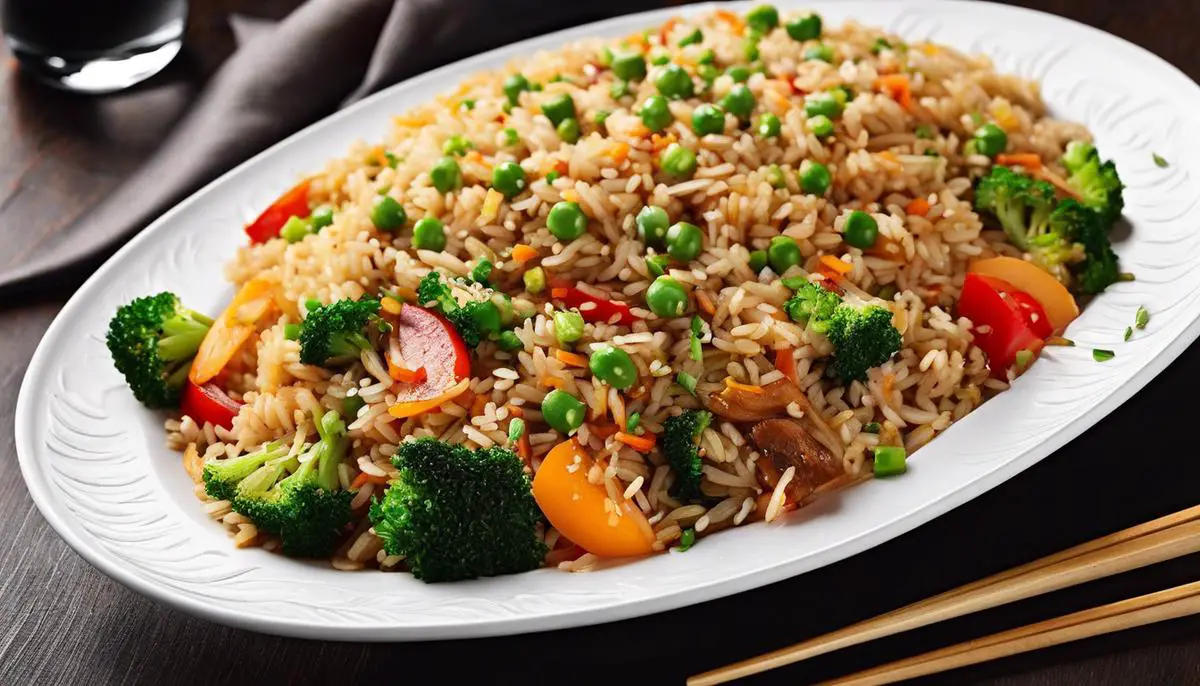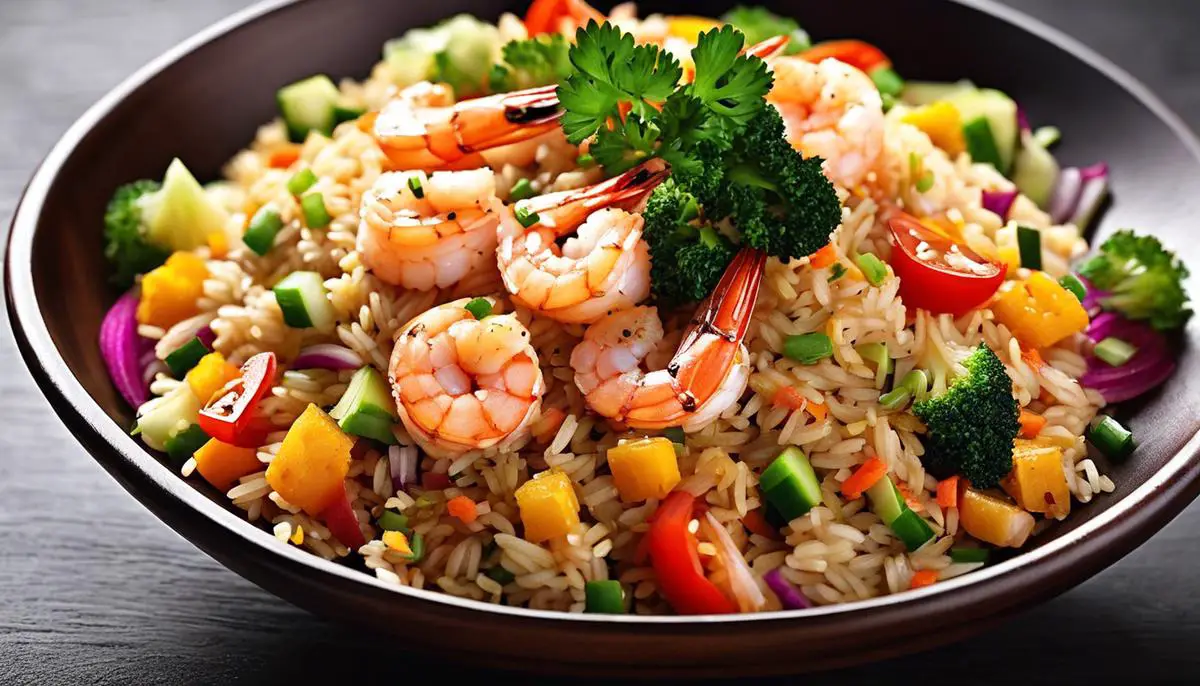Embarking on a culinary adventure often begins with the comforting and universally-loved dish of fried rice, which brings together simplicity and inviting flavors in one skillet. The beauty of fried rice lies in its versatility and ease of preparation, making it a favorite amongst families and quick meal enthusiasts alike. Whether you’re a beginner to the stir-fry world or looking to perfect your technique, understanding the fundamentals is key. From choosing the right type of rice to achieving the perfect mise en place, we set the stage for the symphony of flavors that you can create. Let’s dive into the realm of aromatic seasonings, vibrant vegetables, and wholesome proteins to learn the art of curating the perfect bowl of fried rice.
Preparing Ingredients
Mastering the Art of Simple Fried Rice: A Step-by-Step Ingredient Prep Guide
Food fanatics and kitchen experimenters, brace yourselves for an adventure through the tantalizing world of simple fried rice. This classic dish is the epitome of comfort food and the perfect canvas for culinary creativity. Whether you’ve got a penchant for heat, a soft spot for umami, or a love affair with fresh veggies, prepping your ingredients for fried rice is like painting with the boldest flavors from your palate’s palette.
First, select your rice. You’ll want cold, day-old rice, ideally a medium to long grain like Jasmine or Basmati—this ensures each grain remains separate and doesn’t turn into a mushy affair. If you’re in a pinch and don’t have leftover rice, cook a fresh batch and spread it out on a sheet to cool rapidly. Even pop it into the fridge to eliminate extra moisture if you can spare the minutes. Dryer rice means crispier fried rice that every true food aficionado craves.
Now, let’s talk about the cornerstone of flavor—aromatics. Finely dice some onions, mince garlic, and grate fresh ginger. These three musketeers of flavor lay down the foundational beats that will carry the symphony of your simple fried rice.
Protein comes next. Whether you’re fawning over chicken, shrimp, tofu, or keeping it classic with some beaten egg, your protein needs to be prepped and ready to go. Slice chicken or tofu into bite-sized pieces, peel and de-vein the shrimp, and whisk eggs with a touch of salt. These will be quickly cooked and set aside, ready to join the dance at the final stage.
Vegetables add color, texture, and health benefits to your fried rice. Carrots, peas, bell peppers, and green onions are traditional, but one of the joys of fried rice lies in its versatility; anything goes! Dice these beauties uniformly for even cooking—remember, we eat with our eyes as much as our palates!
Soy sauce, oyster sauce, or a dash of fish sauce? Choose your combination for that umami depth. Have these seasonings measured and the bottle ready for that quick pour. And for those who dare spice, keep that bottle of Sriracha or a pinch of red pepper flakes at arm’s reach.
Before the skillet or wok calls for you, have your mise en place lined up like a gustatory guard of honor. The actual cooking of fried rice is fast and furious, so organization is the key to not missing a beat.
Start the rhythm with your aromatics and protein, follow the flow with veggies, and then let the rice join the groove. A drizzle of your chosen sauces, a quick toss, a sprinkle of green onions for that final fresh hit, and voilà—simple fried rice, a dish that sings of home comforts, personal innovation, and the joy of shared plates.
Fellow flavor seekers, the quest for simple yet spectacular fried rice is clear: Prep meticulously, cook passionately, and serve generously. Let the grains tell their story as they dance in the wok, seasoned by your hand, and flavored by the world.

Stir-Frying Techniques
Ah, stir-frying, that quintessential technique that transforms humble ingredients into a symphony of flavors and textures; the heart of making a stellar fried rice. It’s not just about tossing and turning ingredients in a wok—there’s an art to achieving that perfect sear and texture.
The secret? It’s all in the heat. The magic of stir-frying is conducted at high temperatures. This means cranking up the gas and letting the wok reach a smoke point before introducing the rice. The oil must shimmer with the promise of what’s to come—this isn’t the time for timid cooks. Use a neutral oil with a high smoke point, like peanut or vegetable oil, for that sear without the burn.
And let’s talk about the vessel. The wok is more than a pan; it’s the culinary stage where fried rice comes to life. A well-seasoned carbon steel wok delivers supreme heat distribution and the coveted ‘wok hei’, that ineffable charred aroma that’s the hallmark of a great stir-fry. Don’t have a wok? A wide, non-stick skillet can pinch-hit in a pinch, but be aware you might not achieve the same smoky essence.
As for the cook’s dance, it’s all in the wrist. Stirring technique is key—this is a fry, not a scramble or a sauté. Employ a spatula to toss and fold the rice with grace, allowing it to kiss the hot surface of the wok without clumping or scorching. It’s a rhythmic swish-swirl-sizzle that keeps everything moving and cooking evenly.
The timing? Swift like a well-rehearsed tango. Each ingredient should spend just enough time in the wok to reach its zenith. Veggies need a quick sauté to maintain their crisp edge; the rice, to be kissed by the flame but not burnt. Protein shores up the dish, turned in the wok just until it’s perfectly done, but careful, overcooking will yield a chewy disappointment.
Amidst the sizzle and steam, a splash of sauce joins the fray at just the right moment. Balance is key here; a heavy hand can make the rice soggy, washing out the vibrant melody into a monotonous tune. Strive for a glistening sheen on the rice grains, each one perfectly coated but not swimming in sauce.
Lastly, let’s not forget the garnish—an encore of flavor if you will. A sprinkle of fresh herbs, a scatter of toasted sesame seeds, an extra drizzle of spicy chili oil to awaken the palate. These final flourishes enhance not just the flavor but the visual appeal, transforming the dish into a feast for all senses.
Remember, above all, confidence is your companion in the kitchen. Trust the heat, trust the wok, and trust the dance of stir-frying. With each flick of the wrist and leap in the heat, fried rice becomes more than a dish—it’s an edible testament to the joy of cooking.

Seasoning and Flavoring
Ah, fried rice – the quintessential comfort dish that dances on the palate with its savory, smoky notes, and a rainbow of textures. While a well-cooked grain is indisputably the star of the show, spices and sauces are the indispensable supporting cast that elevate a good fried rice to great. Their role? To infuse every grain with bursts of flavor that sing harmoniously together.
For those about to embark on a fried rice journey, the myriad of spices and sauces can seem daunting. Fear not! Let’s break it down to the essentials – the must-haves in any fried rice aficionado’s arsenal.
- Soy Sauce – An undeniable hero in Asian cooking, soy sauce is a must for creating that classic umami taste. Light soy sauce works best, imparting a subtle saltiness without overpowering the dish. It’s the backbone of flavor for fried rice, weaving its magic into every bite.
- Sesame Oil – While not exactly a sauce, a few drops of sesame oil added at the end of cooking can do wonders. Think of it as the finishing touch, a fragrant oil that gives the rice a nutty, toasted edge. Remember, a little goes a long way here.
- Oyster Sauce – This viscous sauce brings a velvety texture and a depth of sweetness that counteracts the saltiness of the soy. A tablespoon or two can bring a touch of luxurious flavor that binds all the ingredients in fried rice.
- Fish Sauce – Adventure in every drop! This potent, briny concoction adds complexity and a punch of flavor. Used sparingly, fish sauce can imbue your dish with hints of oceanic savoriness that’s quite irresistible.
- Chili Sauce or Chili Oil – For those who like it hot, introducing chili sauce or oil is a game changer. It brings heat, but also depth, often with notes of garlic and sometimes a mild sweetness.
- Hoisin Sauce – Occasionally, hoisin can be used for a sweeter, more molasses-like taste that plays well with the saltier components. Just a teaspoon can transform the flavor profile of your fried rice.
- Sriracha – When the goal is to balance heat with a tinge of garlic and sugar, sriracha is the go-to. It’s become a modern-day staple in many fried rice variations for good reason.
- Freshly Ground Black Pepper – Never underestimate spices in their simplest form. Black pepper offers a sharp, earthy kick that is often all a dish needs to go from flat to flavorful.
- White Pepper – Alternatively, for a different dimension of heat that hits the back of the throat, white pepper is a subtle yet influential spice that complements fried rice beautifully.
- Rice Vinegar – In some recipes, a dash of rice vinegar can brighten up the dish, adding just the right amount of acidity to cut through the richness of the oils and sauces.
Remember, the key to the ultimate fried rice lies in balance – salty, sweet, heat, and a touch of umami create a symphony of flavors. And while the variety of spices and sauces may be expansive, these are the fundamental elements that will ensure a show-stopping fried rice. It’s all about creating a flavor palate that resonates with you, bringing authenticity and inventiveness to the table with every steaming bowl of this timeless dish. Happy stir-frying!

The allure of fried rice is undeniable, with its ability to showcase culinary creativity while nourishing the soul. With your skillful preparation of ingredients, mastery of the stir-frying technique, and the thoughtful layering of seasonings, you’re now equipped to bring this staple dish to life in your own kitchen. Remember that each element from the steaming jasmine rice to the last drop of sesame oil tells a story, a story steeped in tradition yet allowing for personal adaptation. Savor the satisfaction that comes with creating a dish that is as nutritious as it is delicious, and let this be only the beginning of your fried rice journey!
